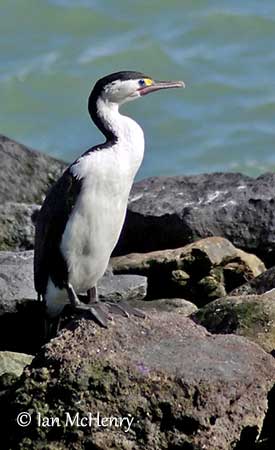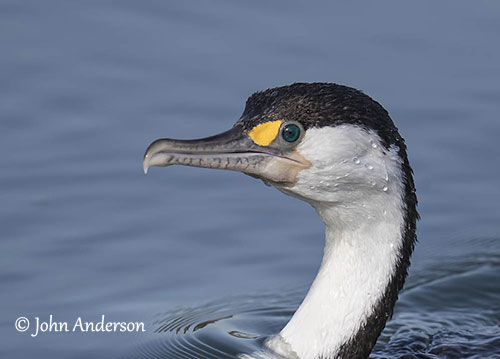
Fr: Cormoran varié
Ang: Australian Pied Cormorant - Pied Cormorant or Shag – Great Pied Cormorant
All: Elsterscharbe
Esp: Cormorán Pío
Ita: Cormorano bianconero maggiore
Nd: Bonte Aalscholver
Sd: australisk skarv
Photographers:
John Anderson
John Anderson Photo Galleries
Jean Michel Fenerole
Photos d’Oiseaux du monde
Ken Havard
My Bird Gallery & Flickr gallery 1 & Flickr gallery 2
Patrick Ingremeau
TAMANDUA
Ian McHenry
My New Zealand Birds
Text by Nicole Bouglouan
Sources:
HANDBOOK OF THE BIRDS OF THE WORLD vol 1 by Josep del Hoyo-Andrew Elliot-Jordi Sargatal - Lynx Edicions - ISBN: 8487334105
Birds in backyards (Birds Australia and Australian Museum)
Habitat use and group size of pied cormorants (Phalacrocorax varius) in a seagrass ecosystem: possible effects of food abundance and predation risk
Wikipedia, the free encyclopaedia
Page famille Phalacrocoracidés
Australian Pied Cormorant or Pied Shag
Phalacrocorax varius
Suliformes Order - Phalacrocoracidae Family
INTRODUCTION:
The Australian Pied Cormorant is found in Australia and New Zealand where it frequents estuaries, harbours and bays, but also mangroves and large wetlands in E Australia.
It typically feeds on fish, crustaceans, molluscs and cephalopods. It dives during about 40 seconds to catch a prey while swimming underwater.
It usually breeds in colonies established in harbours, estuaries or lakes, about 400 metres from the sea. They are monogamous and both parents share the nesting duties.
The Australian Pied Cormorant is not globally threatened for the moment.

DESCRIPTION OF THE BIRD:
Biometrics:
Length: 65-85 cm
Wingspan: 110-130 cm
Weight: 1300-2100 g
The Australian Pied Cormorant of nominate race has black and white plumage. The upperparts including forehead, crown, nape, hindneck, mantle, back, rump, wings and tail are black. The back is glossed green.
The underparts are white, except the blackish underwing and tail. The thighs are black.
In breeding plumage, we can see some white feathers on crown and hindneck.
There is a small, black, pointed marking from the side of the occipital area to the rear of the ear-coverts.
The long, hooked bill is grey. The eyes are green, surrounded by bare, blue eyering, and there is a small, bright blue area just below the eye. The lores are yellow, whereas gape, base of mandible and bare throat are pale pinkish. Legs and webbed feet are black.
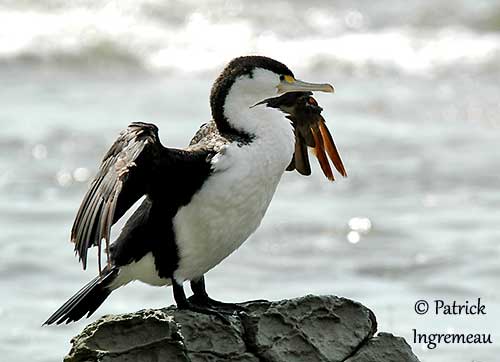
The bird is duller outside breeding season, especially the bare skin of the head.
Male and female have similar plumage, but the female is smaller with shorter bill.
The juvenile resembles adult but it is duller, with the upperparts tinged dull brown on mantle and upperwing. Some paler brownish tips are visible on greater coverts. The head sides are mainly dull brown with variable amount of whitish.
On the underparts, a variable dark brown mottling extends from rear throat to undertail-coverts. Some birds are largely dark brown on the underparts, with some whitish feather bases, involving a mottled appearance.
The eyes are dark bluish-grey. The dull lores soon turn into yellow.
SUBSPECIES AND RANGE:
The Australian Pied Cormorant has two subspecies.
P.v. varius (described above) is found in New Zealand (North Island - South Island - Stewart Island).
P.v. hypoleucos is found in Australia throughout mainland, but it is more common in the southern region and along the coast of SE Australia. It avoids the driest parts of the interior.
This race is similar to nominate, but the bare parts of the face are brighter with orange lores rather than yellow. The black marking on the rear of ear-coverts is absent. The white on face extends narrowly above the eye.
Mantle to upperwing shows bluish sheen, not greenish. The bill is slightly longer.
The juvenile has more white on the underparts.
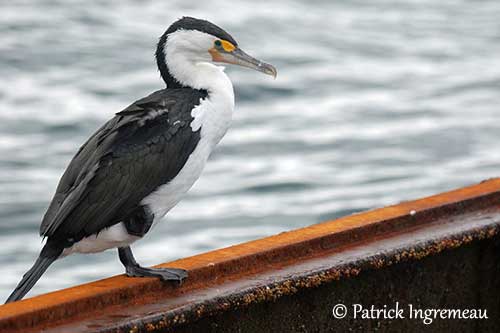
HABITAT:
The Australian Pied Cormorant of W Australia frequents marine habitats such as estuaries, bays and harbours. In E Australia, it is mainly found in mangroves and large inland wetlands.
In New Zealand, it is generally found in coastal areas. It forages in coastal marine waters, harbours and estuaries, although it also frequents occasionally freshwater lakes and ponds near the coast.
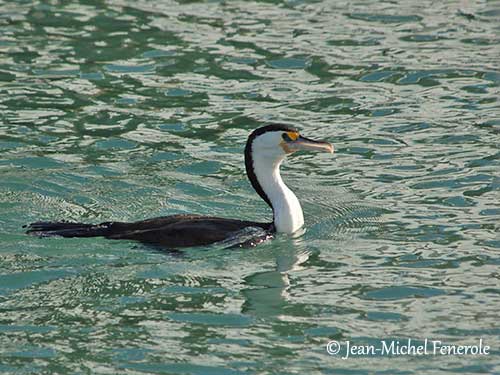
CALLS AND SONGS: SOUNDS BY XENO-CANTO
The Australian Pied Cormorant is usually silent away from the breeding colonies. However, it becomes more vocal during pair formation and nest building. Both mates also communicate during the incubation, when one of them returns to the nest.
The male gives louds, guttural “aark”, cackling sounds, croaks and screams “whee-eh-eh-eh”. The female utters wheezy “haa” calls. The begging young give high-pitched “krweee…krweee…krweee…”
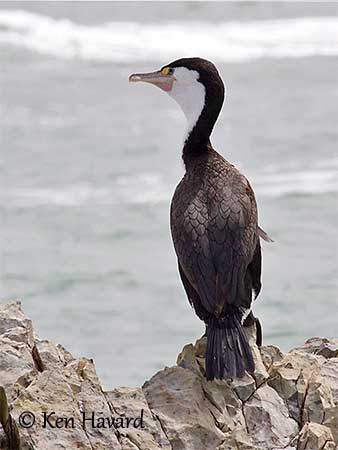
BEHAVIOUR IN THE WILD:
The Australian Pied Cormorant feeds primarily on fish, but it also takes crustaceans, molluscs and cephalopods.
It typically gets the food underwater, by diving and swimming thanks to the large webbed feet helping for propulsion. It forages mainly by pursuit-diving. The eyes are protected by nictitating membranes while underwater.
Like other cormorants, it is regularly seen perched on rocks with the wings outstretched to dry the feathers when returning from water.
This species usually forages alone in water less than 10 metres deep. But at sea, they may form foraging flocks.
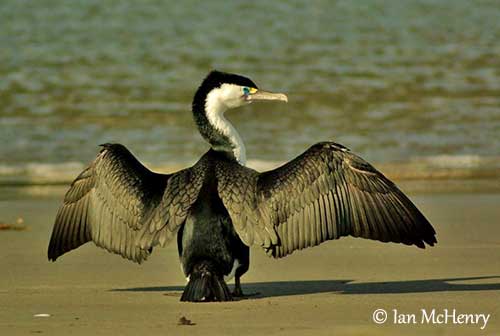
The Australian Pied Cormorant breeds usually in colonies. It is monogamous.
The male performs the courtship displays close to the future nesting site. Wing-waving by the male is performed in silence, but the female produces a gargling in response. In order to attract the female attention, the male may also hop up to 1 metre in the air with both feet.
Both parents share the nesting duties.
The Australian Pied Cormorant adult is sedentary but the juveniles disperse widely over long distances.
In the interior, the numbers are related to food abundance and water levels.
The flight is lower and weaker than in other species. The flocks fly in V formation.
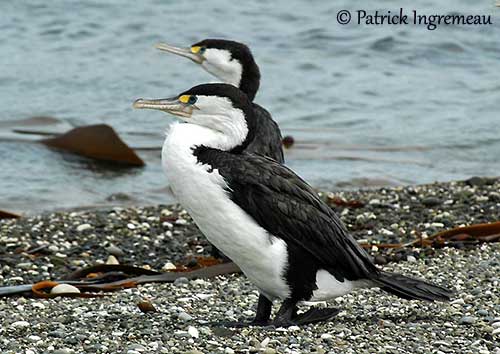
REPRODUCTION OF THIS SPECIES:
The breeding season varies with both range and year, depending on water levels. In coastal areas, this period takes place mainly in spring and autumn.
The Australian Pied Cormorant breeds colonially, sometimes in very large colonies, and often in mixed colonies with other bird species. These colonies are established on coastal islands, flooded tree plains, mangroves, and sometimes on artificial structures.
In New Zealand, they nest mainly in trees along coastal cliffs or near freshwater lakes close to the coast.
The large nest is made with twigs, sticks and seaweed cemented together with droppings. It is built by both adults and usually reused twice a year and refurbished at the beginning of the nesting cycle. The nest is sometimes placed on the ground.
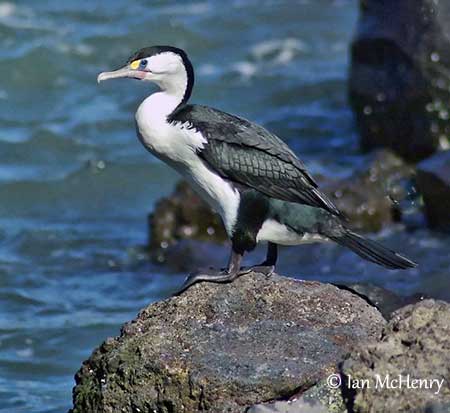
The female lays 2-5 whitish eggs with some scattered orange spots. Both adults incubate during 25-33 days. At hatching, the chicks are naked, but a dark brown down appears very soon. The underparts are white.
They are fed by both parents by regurgitation. They fledge between 47 and 60 days after hatching. They remain at or near the colony and are fed by the adults during 10-11 weeks more. They are sexually mature at 2 years or more.
PROTECTION / THREATS / STATUS:
The Australian Pied Cormorant is less affected by habitat destruction than other species, as it is more often in coastal waters or in open waters in the interior. It also takes advantage of artificial water bodies. It is well adapted to introduced fish species and takes them extensively.
The size of the population is unknown, but the species is not considered globally threatened for the moment.
The Australian Pied Cormorant is currently evaluated as Least Concern.
